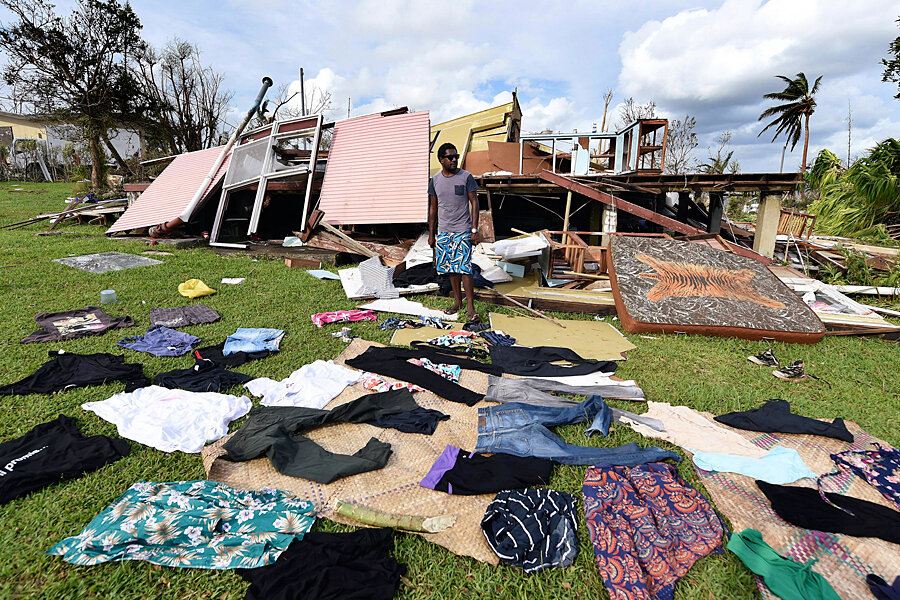Cyclone Pam: Relief workers see flattened areas, struggle to reach hardest hit
Loading...
| Port Vila, Vanuatu
Relief workers saw a flattened landscape and widespread destruction in Vanuatu's outer islands Tuesday after struggling for days to reach the areas of the South Pacific nation hardest hit by a fierce cyclone.
Radio and telephone communications with the outer islands were just beginning to be restored, but remained incredibly patchy three days after Cyclone Pam hit.
Australian military planes that conducted aerial assessments found significant damage, particularly on Tanna Island, where it appears that more than 80 percent of homes and other buildings were partially or completely destroyed, Foreign Minister Julie Bishop said.
"We understand that the reconnaissance imagery shows widespread devastation," Bishop said. "Not only buildings flattened — palm plantations, trees. It's quite a devastating sight."
Teams of aid workers and government officials carrying medical and sanitation supplies, water, food and shelter equipment managed to land on Tanna and neighboring Erromango Island on Tuesday afternoon, said Colin Collett van Rooyen, Vanuatu director for aid group Oxfam. The two islands were directly in the path of the storm, which packed winds of 270 kilometers (168 miles) per hour when it hit early Saturday.
The destruction on Tanna was significantly worse than in the nation's capital of Port Vila, where Pam destroyed or damaged 90 percent of the buildings, said Tom Perry, spokesman for CARE Australia.
"The airport was badly damaged, the hospital was badly damaged but still functioning ... there's one doctor there at the moment," he said. "It's obviously a pretty trying situation."
The U.N. Office for the Coordination of Humanitarian Affairs reported that 11 people were confirmed dead, including five on Tanna, lowering their earlier report of 24 casualties after realizing some of the victims had been counted more than once. Officials with the National Disaster Management Office said they had no accurate figures on how many were dead, and aid agencies reported varying numbers.
The confusion over how many died in the storm reflects the difficulty officials face as they try to deal with a disaster spread across many remote islands amid a near-total communications blackout.
"Vanuatu is a challenging place at the best of times, in the sense of getting around and logistics," Perry said. "So a situation like this is pretty testing."
Poor weather and communications issues have hampered relief workers efforts to reach the outer islands for days. A break in the weather on Tuesday gave them a chance to try again, though access remained difficult. Most of the islands have no airports and those that do have only small landing strips that are tricky for large supply planes to navigate. On the main island of Efate, bridges were down outside Port Vila, impeding vehicle traffic.
"There are over 80 islands that make up Vanuatu and on a good, sunny day outside of cyclone season it's difficult to get to many of them," said Collett van Rooyen of Oxfam. "Until today, the weather has been particularly cloudy, so even the surveillance flights would have had some difficulty picking up good imagery."
The relief teams on Tanna and Erromango were planning to meet with local disaster officials and conduct damage assessments, said Sebastian Rhodes Stampa, disaster coordinator for the U.N.'s humanitarian affairs office.
Some of the islands were just beginning to get their phone networks running again, and technical crews were en route to set up data and voice satellite communications. Officials hoped to restore communications to the islands within 48 hours, Stampa said.
Photos of the islands taken by crews on board Australian, New Zealand and New Caledonian military surveillance flights were being analyzed in the capital, Port Vila. The information will help officials dispatch aid to the worst-hit areas, Stampa said.
"Tanna has a problem with its water anyway; it's dry outside the disaster season, so there's a reasonable chance there's a lack of water there," Stampa said.
Collett van Rooyen spoke to another aid worker who had managed to land in Tanna.
"His description in two words is 'utter devastation,'" he said.
Vanuatu has a population of 267,000 people. About 47,000 people live in the capital.
The U.N. Office for the Coordination of Humanitarian Affairs said 3,300 people were sheltering in dozens of evacuation centers on the main island of Efate and in the provinces of Torba and Penama.
In the capital, residents had already begun the process of rebuilding their homes, and the sounds of laughter could be heard ringing out in the streets.
"There's a real sense today, a real kind of 'let's get on with it,'" said Perry, of CARE Australia. "People are very positive; You don't have people sitting around just kind of staring at the sky or anything."
____
Associated Press writers Kristen Gelineau in Sydney and Edith M. Lederer at the United Nations contributed to this report.







